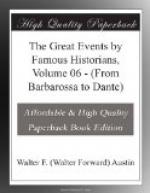The distribution was made during the latter end of April. Many works of art in bronze were sent to the melting-pot to be coined. Many statues were broken up in order to obtain the metals with which they were adorned. The conquerors knew nothing and cared nothing for the art which had added value to the metal. The weight of the bronze was to them the only question of interest. The works of art which they destroyed were sacrificed not to any sentiment like that of the Moslem against images which they believed to be idols or talismans. No such excuse can be made for the Christians of the West Their motive for destroying so much that was valuable was neither fanaticism nor religion. It was the simple greed for gain. No sentiment restrained their cupidity. The great statue of the Virgin which ornamented the Taurus was sent as unhesitatingly to the furnace as the figure of Hercules. No object was sufficiently sacred, none sufficiently beautiful, to be worth saving if it could be converted into cash. Amid so much that was destroyed it is impossible that there were not a considerable number of works of art of the best periods. The one list which has been left us by the Greek logothete professes to give account of only the larger statues which were sent to the melting-pot. But it is worth while to note what were these principal objects so destroyed.
Constantinople had long been the great storehouse of works of art and of Christian relics, the latter of which were usually encased with all the skill that wealth could buy or art furnish. It had the great advantage over the elder Rome that it had never been plundered by hordes of barbarians. Its streets and public places had been adorned for centuries with statues in bronze or marble. In reading the works of the historians of the Lower Empire the reader cannot fail to be struck alike with the abundance of works of art and with the appreciation in which they were held by the writers.
First among the buildings as among the works of art, in the estimation of every citizen, was Hagia Sophia. It was emphatically the Great Church. Tried by any test, it is one of the most beautiful of human creations. Nothing in Western Europe even now gives a spectator who is able with an educated eye to restore it to something like its former condition, so deep an impression of unity, harmony, richness, and beauty in decoration as does the interior of the masterpiece of Justinian. All that wealth could supply and art produce had been lavished upon its interior—at that time, and for long afterward, the only portion of a church which the Christian architect thought deserving of study. “Internally, at least,” says a great authority on architecture, “the verdict seems inevitable that Santa Sophia is the most perfect and most beautiful church which has yet been erected by any Christian people. When its furniture was complete the verdict would have been still more strongly in its favor.”




